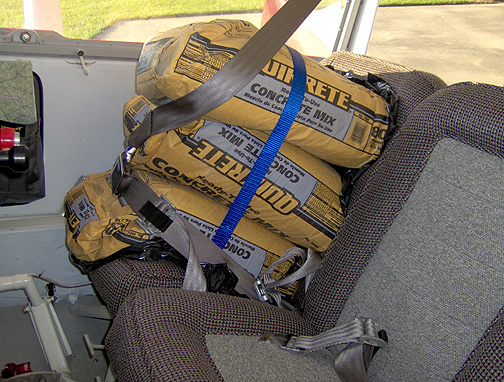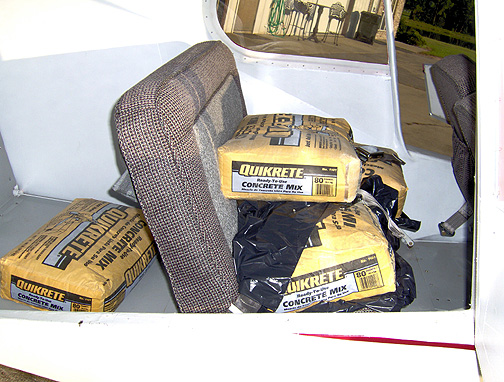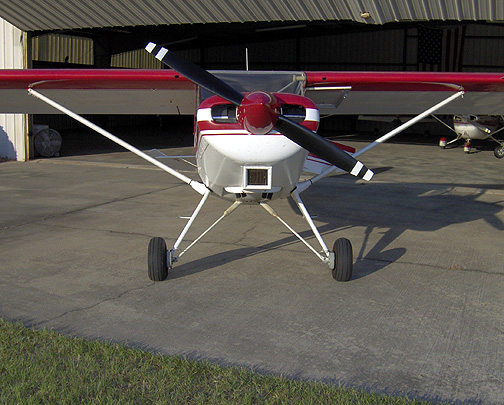
Yep - that's three 80 lb. bags of concrete. I needed some concrete for project at the house anyway, so I used it for the weight and CG testing.
August 10, 2008
I now have 25 hours on N57EN (Miss'ippi Mudbug). I have completed most all of the test flight program that I had outlined at the beginning of my phase one test flying. Click here to download my Phase One Test Flight Cards
So far no surprises. The Bearhawk performs exactly as expected and has no bad flying habits. I continually feel like this airplane is much more capable than it's pilot when I'm flying it. I know that it can do much more than I am demanding of it.
Performance Testing:
As previously noted, N57EN is equipped with a Bob Barrows built Lycoming
O-360 EXP de-rated to allow me to burn 93 octane mogas. At the time I bought
the engine, I had no idea that 100LL would exceed $5 a gallon (as of this
writing it's $5.40 at my airport) so my choice was a wise one. I gave up
a few horsepower but I am now burning much cheaper auto fuel, or I can burn
100LL if I need to (like on a cross country trip).
The propeller on N57EN a Sensenich fixed pitch prop (76" diameter x 56 pitch). When you have fixed pitch prop, it is a series of compromises. If you want to be able to get off the ground in a short distance and climb quickly, you need a finer pitch (climb prop) but will give up some performance when in the cruise portion of the flight. If you want to cruise faster, you can go for a coarse pitch (cruise prop) and you will cruise faster, but will give up some performance on your takeoff distance and climb.
I definitely have a "climb" prop. With 2 notches of flaps, I take off in 300 feet on a calm wind day with 95 degrees temps outside. After raising the flaps up, it climbs at 1100 FPM at 85 mph. However, if I lower the nose to climb at 95 MPH, which gives better visibility over the nose, I exceed the redline RPM of 2700 and have to throttle back a little. I talked with Bob Barrows and he suggests that before having the prop re-pitched, I get a RPM checking device to make sure that my RPM readings are accurate. As of this writing, the RPM checker is on order and has been shipped. It is a device that you point at the prop and it will count the blades and give you an accurate RPM readout.
Engine Break In:
As I said before, I have a climb prop. I have been flying around at about
2400 to 2500 RPM for all of these first 20 hours. Since my Manifold Pressure
readout wasn't working, I had no idea that I wasn't at 75% power as is
recommended for proper engine break-in. Currently I'm burning 1 quart every
3 hours and the oil analysis at the 15 hour mark showed high levels of chrome
so I know the break in is not yet complete. I do know that I haven't glazed
the cylinders because I have never had a cylinder head temperature higher
than 400F. I am due for an oil change now, so will do it the next time I
fly and send it in for oil analysis again.
Cruise Testing:
I have been putting off my cruise and fuel flow testing because of the lack
of Manifold Pressure readings on the EIS system. After a call to the
manufacturer, I found out it was a programming issue and I was able to correct
it. Now that it's working, I can more accurately figure my percent
of power.
In theory with my engine, you should be able to achieve 75% power, at full throttle at 8000 feet (density altitude with the altimeter set to 29.92'). So I decided to do my fuel flow testing and cruise speed performance at 8000 feet where the air is thinner and cooler. I was once again reminded that I have a climb prop. When I levelled off at 8000 feet I left the throttle firewalled and ended up exceeding the 2700 redline by quite a bit. In fact I had to throttle back to about 3/4 throttle to get down to the 2700 RPM redline. At that point my manifold pressure indicated only 18" so I was at about 65% power. Since I was there anyway, I decided to continue on with the fuel flow testing.
Here is my performance so far (with a climb prop). At 8000 feet, 65% power I get 135 MPH TAS while burning 8 GPH. That is exactly where it should be for the 180 horsepower engine.
To check the fuel flow, I started out with full fuel tanks, then placed the fuel selector valve on "LEFT" for the takeoff and climb up to 8,000 feet. After levelling off at 8,000 feet (D.A.) I got it into a stabilized in cruise at 65% power and set the mixture to 50 degrees rich of peak. I then switched to the "RIGHT" tank and flew at that altitude and power setting for exactly one hour (while listening to blues music on my XM satellite radio). The air was smooth and cool. The TAS at 65% power at 8000 feet was 135 MPH. After exactly one hour, I switched back to the "LEFT" tank for the descent and landing. After landing, the fuel in the right tank was measured and was down exactly 8 gallons. The left tank was down about 5 gallons.
At 2000 feet I can get the engine up to 75% power, but to do it I have to run at 2650 RPM which gives me about 21.5" manifold pressure. She does about 137 MPH TAS at 2000 feet at 75% power, burning 9.5 GPH.
In summary, I would like to switch to either a 58 or 60 pitch prop to see what my numbers look like. I think with the right prop I'll most likely see 140 to 145 MPH TAS at 75% power. Bob asked that I wait until I can check the accuracy of my RPM readout before changing props, so I will.
Gross Weight and Aft CG testing:
Up to this point, I have been flying by myself as required by the FAA until
the 40 hour phase one flight testing is complete. To test the performance
and handling of the Bearhawk at gross weight and at a more aft C.G., I had
to load it up with some "passengers" and luggage. This is another one of
those "sneak up on it" deals that I'm always talking about. You don't
want to just load it up to the max. and go flying. It's best to gradually
add weight a little at a time, and then test fly it before adding more.
I started with a 240 lb "passenger" in the front seat next to me:

Yep - that's three 80 lb. bags of concrete. I needed some concrete for
project at the house anyway, so I used it for the weight and CG testing.
I weighed the bags of concrete on a scale and found them to be right at 80 lbs each. The bags were well strapped down and seat belted in place. Confession time - I weigh about 270 lbs (way too fat, but I'm working on it) so with me and 240 lbs of concrete, I had 510 lbs up front.
After each test flight, I added one bag to the rear seat or to the baggage compartment and then flew again, doing stability tests each time to assure that I wasn't getting too far aft on the C.G. Also, the fuel tanks were topped after each test flight to maintain consistency in all of the testing.
Here is what the rear seat and baggage compartment looked like for Test 5:

In addition to the four 80 lb bags of concrete shown above, there were
still three 80 lb bags in the front seat. So in all, I carried 560 lbs. of
concrete plus me at 270 lbs, plus full fuel (312 lbs), for a total gross
weight of 2,480 lbs.
The following are the weight & CG of the five flight tests, gradually adding the weight one bag at a time:
Test Flight 1: Full fuel, 510 lbs in the front seats + empty rear seat + empty baggage area = 2,160 gross weight and a CG of 14.3"
Test Flight 2: Full fuel, 510 lbs in the front seats + 80 lbs in the rear seat + empty baggage area = 2,240 gross weight and a CG of 15.7"
Test Flight 3: Full fuel, 510 lbs in the front seats + 80 lbs in the rear seat + 80 lbs in the baggage area = 2,320 gross weight and a CG of 17.8"
Test Flight 4: Full fuel, 510 lbs in the front seats + 160 lbs in the rear seat + 80 lbs in the baggage area = 2,400 gross weight and a CG of 18.9"
Test Flight 5: Full fuel, 510 lbs in the front seats + 240 lbs in the rear seat + 80 lbs in the baggage area = 2,480 gross weight and a CG of 20"
To test stability at each weight and CG tested, I levelled off and got it trimmed for straight and level flight at about 110 MPH IAS. Once it stabilized, I pulled back on the stick until it slowed to 100 MPH IAS and then let go. This tests for positive stability. If the nose drops below the horizon and as speed builds, it pitches back up again, you have positive stability. If you pull the nose up and it stays put at the new speed, you have neutral stability. If it requires a push force to keep the nose from rising even more, you have negative stability and a CG that is dangerously too far aft.
Test 1 - (2160 lbs - 14.3" CG) I could feel the difference in take off roll and climb rate but it wasn't significant. The stability tests were very benign and it came back to the original trim speed within a few oscillations.
Test 2 - (2240 lbs - 15.7" CG) Takeoff roll was a bit longer and my usual 1100 FPM climb was more like 900 FPM. In the stability tests, the oscillations were a bit more pronounced and it took about 6 or 7 before it levelled out to the original trim speed.
Test 3 - (2320 lbs - 17.8" CG) With the extra 80 lbs. in the baggage area, the tail took a long time to come up and my usual 300 ft take off distance was now about 500 feet. I climbed out at 80 mph and the climb rate was about 800 FPM now. In the stability tests, the oscillations were now quite pronounced. With about a 20 degree pitch down and then up, it took about 10 to 12 times before it started to finally level out to the original trim speed.
Test 4 - (2400 lbs - 18.9" CG) Pretty much the same as test 3 but the take off distance is now about 600 feet. Still have good positive stability but the oscillations are more pronounced, with up and down pitch of about 25 to 30 degrees.
Test 5 - (2480 lbs - 20" CG) Take off distance was about 800 feet and climb was about 700 FPM on the 92 degree testing day (density altitude is 2200 feet). Still have positive pitch stability and the airplane was very stabile and completely controllable and stick forces were still very positive even at gross weight and a more aft CG.
While I did test it at close to max gross weight, I never got the C.G. any further aft than 20" (22.5" is the max.).
The Bearhawk flys great loaded up with weight and in fact, in some ways, it flys even better (especially landings). As expected, the takeoff roll is longer and the climb is a bit shallower but it still performs very well. This is one area where the O-540 engine would make a big difference. I carried 510 lbs up front and 340 lbs in the back with full fuel. With this testing complete, I now know I could safely carry a couple of 250 lb adults up front with another 250 lb adult in the back, plus 100 lbs baggage or cargo, with full fuel tanks. Or it could easily carry four 200 lb people with 50 lbs. of baggage with full tanks. What a great airplane!
As an interesting side-note, I originally had thought that I had too much
camber in my landing gear and was going to adjust the shock struts out a
bit. Bob advised me to wait until I had it loaded up to gross weight first
before adjusting anything. As it turns out, Bob was right. Here is
the landing gear with the airplane loaded to nearly gross weight (2480 lbs).
This is where I rolled it up to after the flight and got out to take the
picture.:

As you can see, the tires are straight up and down and no camber present.
So I guess I'll leave it as-is for now.
As for the flight characteristics with a heavy load, I will say that the airplane handles really well and seems to like the heavier loads. On these hot summer days, the air is quite bumpy but with some weight added, the Bearhawk becomes much more stabile. Also, as an added bonus, the Bearhawk is much easier to land three point because it tends to flare easier and stay put when it touches down when heavily loaded.
Summary:
All in all, I am extremely pleased with the way my Bearhawk handles and performs. With small change to the prop pitch, I feel like I can cruise along at about 140 to 145 MPH (TAS). Even if I don't change the prop, I can still cruise at 135 MPH at 65% and burn only 8 GPH. I will try 55% power on the next flight to see where the fuel burn and speed is there.
Click here to go back to the Flying index page
Click here to go to the Home page